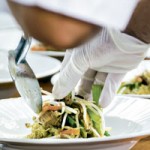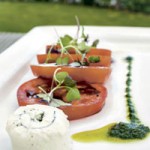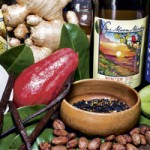Food Fight: Angry About Ahi
He’s angry about ahi, and there’s no time to capitalize or spell correctly: “i was paging through the midweek and came across your article ‘healthy options at grand hyatt,'” emails a reader referring to my article that ran in the Sept. 26 issue of MidWeek Kaua‘i. The article shows a picture of beautifully cooked ahi and focuses on a global Grand Hyatt philosophy: “Food. Thoughtfully Sourced. Carefully Served,” which means the Hyatt buys local and organic food when possible, and prepares it with less salt and fat.
The reader continues: “i wanted to point out that Ahi is not a healthy food. the FDA recommends that pregnant and nursing mothers do not eat because of the mercury content! Ahi has been found to contain large amounts of radiation and heavy metals. Ahi is rapidly going extinct because of the over fishing and poisons in the ocean.”
He concludes: “Kauai shrimp is full of antibiotics and they feed them pellets!! they also dump all their shrimp s–just off shore into the ocean polluting kauai waters. please do some research on what your promoting as ‘healthy options.'”
- The Garden Cafe sources from its own garden and local farmers
- Kaua‘i Marriott Resort uses local ingredients
- Monkeypod Jam uses local fruit
- Employees of Oasis on the Beach shop at the farmers market every week.
- The Right Slice uses local fruit in its pies
- Nani Moon Mead is made with Kaua‘i fruit and honey
Ahi is low in calories, rich in omega 3 fatty acids and a good source of vitamin D. Methylmercury, a byproduct of inorganic mercury, is released into the land and water from mining ore deposits, burning coal and waste, and manufacturing plants.
All large and older fish contain mercury, and while Natural Resources Defense Council ranks ahi (yellowfin tuna) high in mercury, the Food and Drug Administration (FDA) says we can safely eat 12 ounces a week. The Monterey Bay Aquarium Seafood Watch says to avoid ahi worldwide, except what is caught in the U.S. Atlantic and Hawaiian waters.
For the Dec. 29, 2011, issue of MidWeek Kaua‘i, I went to the Kaua‘i Shrimp farm in Kekaha and asked about dumping shrimp effluent into the Pacific Ocean.
“We haven’t done that since 2004, but we have to have a system in place in case of emergency,” said Nancy Kanna, former employee of Kaua‘i Shrimp.
A National Pollutant Discharge Elimination System (NPDES) permit has been issued by the Department of Health for that reason. “We use probiotics in our system and a lot of the waste is reused. Our shrimp is not GMO, and we don’t use antibiotics, growth promoters, sulfites or polyphosphates.”
Angry About Ahi got me thinking. Why are we so militant about our food choices? Aren’t the steps the Hyatt is taking positive? But people won’t eat fish, GMOs, animal protein, cooked food, imported food, conventionally farmed food, or animals and dairy products produced on feedlots.
From a purely hedonistic point of view, food that was grown organically and close to home tastes better. On Kaua‘i, it’s traveled 65 miles at the most, while imported food has traveled thousands of miles.
From an environmental standpoint, fewer resources are used to produce local food. Imported food requires fuel and electricity for packaging (which ends up in the landfill), transportation from the farm to the warehouse, from the warehouse to the port (air or ocean), from the port to the store and from the store to our tables.
To make sure a perfectly round tomato in the sexiest shade of red survives all those miles, we have to mess with what Mother Nature created. And in order to fill the bellies of more than 300 million Americans, we have to grow a lot of food. And because, as Americans, we don’t eat with the seasons, we require all kinds of food, year-round. And we want it for cheap.
In 1994, scientists created the first genetically modified organism (GMO) when they spliced genes from a fish into the cells of a tomato, and created Flavor Savr, a tomato cultivated to increase shelf life. Today, GMOs include animals that grow so big and fast they can barely walk, and suicide seeds that produce drought-and insect-resistant, and herbicide-tolerant plants.
Sounds good. High-yields and hardy crops. And the added benefit from large seed corporations that provide steady jobs, paid vacations and health benefits is hard to ignore.
Seed companies claim there is “no need for, or value in testing the safety of GM foods in humans,” but I like to compare it to the movie Jurassic Park. Nature was manipulated with the best of intentions, only it didn’t work out so well. Genetically, humans and insects have a lot in common, and if a plant can kill an insect upon ingestion, what does it do to us?
More than 8 million farms across the world grow one GMO crop, and monocropping requires massive amounts of pesticides and fertilizers. These chemicals have been traced to the disappearance of bees, called colony collapse disorder. They also pollute our streams and oceans, killing life along the way.
Thousands of cows, chickens and pigs grown on giant livestock farms known as feedlots require vast amounts of water and produce staggering amounts of waste and toxic gasses such as the greenhouse gas methane. Residents near these farms suffer from sore throats, headaches, shortness of breath, wheezing, excessive coughing, diarrhea, seizures, comas and even death.
It seems like every week our food safety is threatened.
Superbugs thrive because we eat antibiotic-laden meat. There’s an outbreak of arsenic in rice, listeria in cheese, salmonella in peanut butter, vegetables and, of course, raw chicken. When was the last time you touched raw chicken?
No wonder we’re mad. We’re mad because we’re scared.
We get angry because we know our food choices matter, and when confronting the indifferent face of corporate America, we feel helpless. We’re scared because the ocean and its inhabitants are in perilous danger and, consequently, so are we. Our world is shrinking and so are our resources.
I’m not perfect. I eat fresh-baked apple pie in the fall, non-organic (meaning GMO) soybeans at the dinner tables of friends, and I buy imported products that are not organic.
But I do the best I can. I grow food, eat less meat, load up at the farmers market every week, buy local and organic products in the grocery and health food stores, and I eat at restaurants that make meals from local food. With 492 properties around the world, the Hyatt’s new philosophy significantly cuts down on the corporation’s carbon footprint, and that’s healthier for us as well as the planet.
Marta Lane is a Kaua‘i-based food writer. For more information, visit TastingKauai.com.






